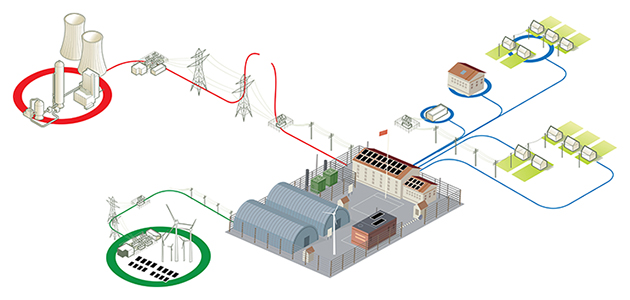Building Unintentional Microgrids on Purpose
Back to Top
Last year, I began to notice an emerging trend in the microgrid market: unintentional, or accidental, microgrids. This is an instance where nearly all the parts of a microgrid already exist on a utility’s grid and can easily be transformed into a microgrid through the addition of a microgrid controller. This indicates how simple incorporating microgrids on the grid can be.
We used to have people say, ‘I want to put a microgrid here,’ as they looked at a wide open field with endless possibilities. Developers would engineer and develop the project from the ground up, integrate it into the grid, and then study it. In the relatively short history of microgrids, that is how nearly all of the existing deployments came about. And of the existing microgrids, many were designed as pilot or one-off projects that developers, utilities, and policymakers could use to better understand the functionality and impact of microgrids on the grid.
Now, we are in the middle of a shift in perspective. We are getting more and more customers saying, ‘I have some distributed generation (wind, solar, etc.), and it’s performing really well. I’ll bet we could incorporate a microgrid around this asset to improve our reliability and add additional services.’
Recognizing these new opportunities for microgrids speaks volumes about the progression of the industry. Developers no longer worry about the validity of microgrid development; there are enough of them deployed at this point to validate the concept.
Not only will the development of unintentional microgrids continue to boost grid reliability, they are also a great way to overcome some cost concerns associated with microgrid development. When your distributed generation and/or energy storage deployment is already paid for through another project, the addition of a microgrid control is a much easier cost to manage than commissioning a microgrid from the ground up.
There certainly are some benefits from designing a microgrid from the ground up. These include complete control over design elements, geographical layouts to optimize your space and make construction easier, and selection of integrated components. These are important factors in development, but the cost savings of not having to pay for distributed generation installation far outweigh the associated costs that come with “finishing” an unintentional microgrid. While the up and coming trend of unintentional microgrids won’t displace planned microgrids, I think we will begin to see more “finishing” and less greenfield development.
I expect this trend to spur faster and wider adoption of microgrids throughout the grid. Pairing these new microgrid development techniques to nearly any distributed generation source works, but it works extremely well with renewable generation. The pairing adds an additional reliability and dispatchability component that is unachievable with renewable distributed generation alone.
As more unintentional microgrid opportunities are identified and “finished” to become real microgrids, we could see a welcomed spike in utility adoption of this practice. It will be even more interesting to see whether future renewable projects that are coupled with energy storage are designed with the intent of becoming a kind-of “planned, unintentional microgrid” down the road.
While S&C hasn’t completed any of these “new-approach” microgrids, we have seen interest building, especially around solar-generation projects. We can see where this is going and are excited to be a part of the perspective change. We know microgrids are quickly moving from the research stage and are ready to break out and become a more significant part of our future grid. Now let’s see how many unintentional microgrids we can build on purpose.